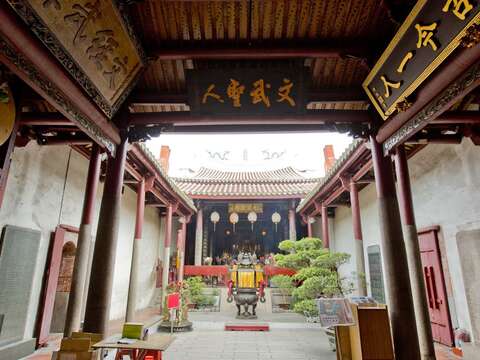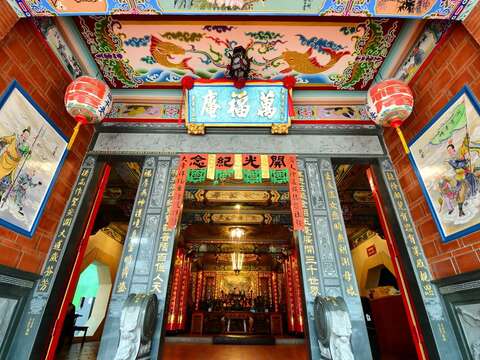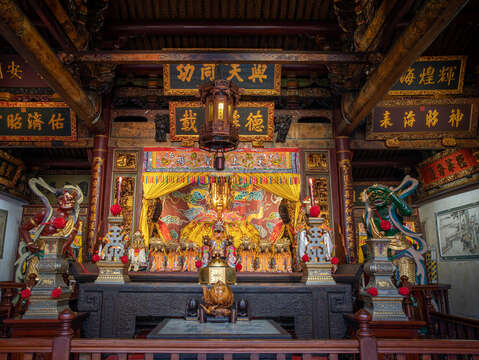Chihkan Culture Park(赤崁文化園區)
Saturday:08:30 – 21:30
4.3Updated:2025-05-07
12k
Introduce
After the Dutch built Fort Zeelandia in Anping in 1624, they decided to build a political and economic center Provintia (today’s Chihkan Tower) across the Taijian (called Chihkan by local plain indigenous peoples in that time) for the geopolitical reason. The Dutch also developed Chihkan Street (Rua Provintia) to start the commercial history of busy business in Tainan.
Chihkan Tower is the largest landmark of the Chihkan Culture Park covering the east of Xinmei Street, south of Chengkung Road to Minquan Road. In fact, Xinmei Street used to be the coastline of Tainan in the 17th century. Inside the park stand Chihkan Tower, Sidian Da Tianhou (Ritual Grand Heavenly Empress) Temple, Sidian Wumiao (Ritual General Guan Temple) and other historical monuments for visitors to rediscover the historical track of Tainan from Dutch occupation through the Kingdom of Tungning to the Qing dynasty.
Chihkan Tower is the center of development of the old Tainan City. With numerous monuments, the park is one of a few culture parks in Taiwan to see buildings during Dutch occupation through the Kingdom of Tungning. It is noteworthy that there are three national historical monuments in the park. Besides Chihkan Tower specially recommended by The Washington Post in its travel page, the palace of King Ningjing (today’s Da Tianhou (Grand Heavenly Empress) Temple) and the Sidian Wumiao (Ritual General Guan Temple) modified from the Guandi (General Guan) Hall of the King Ningjing. All monuments are worthy of visit.
Old streets and other historical sites, such as the Chen De Jiu Family Hall of (family shrine of an official of the Kingdom of Tungning), the widely worshipped Taiwan’s First Temple of Heaven (Tiangong Temple), the Beiji Temple with tablet with the handwriting of King Ningjing, the Kaiji Ling You Temple with a gold-faced Xuantian Shangdi statue. All are suitable for a historical tour. Visitors looking for traditional crafts or traditional gourmet foods will also find the famous food brands, such as Zaifa Steamed Dumplings, Yi Feng Winter Melon Tea, Baibei Milkfish Soup, Qingzhen Duck Soup, Jindechun Tea, Jiuyongruizhen Traditional Bakery, Wuwanchun Incense Shop, Longxingya Zinc Smith, and so on, in the area.
Why is it called Chihkan Tower? Why are there many old-styled business and street food shops near Chihkan Tower? How is the Chihkan Culture Park formed? Visit the Chihkan Culture Park to explore yesteryears Tainan from Dutch occupation through the Kingdom of Tungning to Qing dynasty.
Chihkan Tower was built by the Dutch in 1652. It was a political and economic center called “Provintia” at the beginning. The “province” is formed by three near square platform cities. They were remodeled into red-tiled cornices in 1886 with a Wenchang Pavilion, a Haishen (Poseidon) Temple, and the Penghu Academy. Over the past 300 years or so, although these buildings have been improved or repaired many times, their roles and importance in Tainan remain unchanged.
The surviving part of Chihkan Tower is formed by the south garden, the north pavilion, and Penglai Pavilion in the west. In the garden filled with plants stands the statue of Cheng-kung ZHENG’s acceptance of the Dutch surrender. At the foundation wall near the garret, there are nine dragon-headed Bixis (stone turtle sculptures) relocated from the side of Dananmen (Great South Gate). On the tablets atop the turtle sculptures recorded the Lin Shuang Wen Incident. These tablets are made in 1788 of granite each erecting on a Bixi (turtle, one of nine sons of the Dragon King characterized by the undertaking heavy duty image) with a double-dragon head. They are commonly called the “turtle tablets”.
Today, there are two Minnan-styled buildings standing on the foundation improved from Provintia. The original castle was very small, with one main building and two watchtowers in the south and the north respectively. Currently, only the gate in the west and the wall in the northeastern corner of the castle survive from Dutch occupation. From these ruins, the brick bonding methods are clearly seen. These bricks from Java of Indonesia were bonded with mortar mixed with glutinous rice juice, syrup, sand, and oyster shells.
Inside the garret, the Haishen Temple sits in the south, while the Wenchang Pavilion in the north. Both have a double-eave hip-and-gable roof. The section between the eaves is the second floor decorated by glazed green vase guardrails. At the lintel of the Haishen Temple hangs the “Chihkan Tower” tablet. Inside the temple is an exhibition hall. The vase-shaped door holes in the east are rather lovely.
The tablet with the handwriting of “Wenchang Ke” (Wenchang Pavilion) of Magistrate Sho-qian SHEN of Taiwan Prefecture is still hung in the pavilion. The first floor is an exhibition hall, while “Great Kui the Star Prince” is worshipped on the second floor. The deity statue is characterized by a brush (pen) in the right hand, an ink container in the left hand, a foot on a turtle, and another foot supporting a ladle, symbolizing coming in first in examinations. Both buildings are built on a foundation, and dragon-shaped imperial paths are built between foundations. On the wall are the scroll-patterned window lattices.
An ancient well stands amidst the pavilion on the second floor. It is said that the well links to Zeelandia. True or not awaits visitors to imagine. The entire raised foundation is surrounded by brick guardrails, and there are lovely cub statutes on guardrails facing south.
On the south wall there are stone tablets erected in different eras, and historical artefacts, such as the stone horse, stone weight, and weightlifting stone, are everywhere in the garden. The lobby of the Penghu Academy is a better-preserved building of the Qing dynasty. Facing west with humble decoration, it is worthy of visit.
Chihkan Tower is the largest landmark of the Chihkan Culture Park covering the east of Xinmei Street, south of Chengkung Road to Minquan Road. In fact, Xinmei Street used to be the coastline of Tainan in the 17th century. Inside the park stand Chihkan Tower, Sidian Da Tianhou (Ritual Grand Heavenly Empress) Temple, Sidian Wumiao (Ritual General Guan Temple) and other historical monuments for visitors to rediscover the historical track of Tainan from Dutch occupation through the Kingdom of Tungning to the Qing dynasty.
Chihkan Tower is the center of development of the old Tainan City. With numerous monuments, the park is one of a few culture parks in Taiwan to see buildings during Dutch occupation through the Kingdom of Tungning. It is noteworthy that there are three national historical monuments in the park. Besides Chihkan Tower specially recommended by The Washington Post in its travel page, the palace of King Ningjing (today’s Da Tianhou (Grand Heavenly Empress) Temple) and the Sidian Wumiao (Ritual General Guan Temple) modified from the Guandi (General Guan) Hall of the King Ningjing. All monuments are worthy of visit.
Old streets and other historical sites, such as the Chen De Jiu Family Hall of (family shrine of an official of the Kingdom of Tungning), the widely worshipped Taiwan’s First Temple of Heaven (Tiangong Temple), the Beiji Temple with tablet with the handwriting of King Ningjing, the Kaiji Ling You Temple with a gold-faced Xuantian Shangdi statue. All are suitable for a historical tour. Visitors looking for traditional crafts or traditional gourmet foods will also find the famous food brands, such as Zaifa Steamed Dumplings, Yi Feng Winter Melon Tea, Baibei Milkfish Soup, Qingzhen Duck Soup, Jindechun Tea, Jiuyongruizhen Traditional Bakery, Wuwanchun Incense Shop, Longxingya Zinc Smith, and so on, in the area.
Why is it called Chihkan Tower? Why are there many old-styled business and street food shops near Chihkan Tower? How is the Chihkan Culture Park formed? Visit the Chihkan Culture Park to explore yesteryears Tainan from Dutch occupation through the Kingdom of Tungning to Qing dynasty.
Chihkan Tower was built by the Dutch in 1652. It was a political and economic center called “Provintia” at the beginning. The “province” is formed by three near square platform cities. They were remodeled into red-tiled cornices in 1886 with a Wenchang Pavilion, a Haishen (Poseidon) Temple, and the Penghu Academy. Over the past 300 years or so, although these buildings have been improved or repaired many times, their roles and importance in Tainan remain unchanged.
The surviving part of Chihkan Tower is formed by the south garden, the north pavilion, and Penglai Pavilion in the west. In the garden filled with plants stands the statue of Cheng-kung ZHENG’s acceptance of the Dutch surrender. At the foundation wall near the garret, there are nine dragon-headed Bixis (stone turtle sculptures) relocated from the side of Dananmen (Great South Gate). On the tablets atop the turtle sculptures recorded the Lin Shuang Wen Incident. These tablets are made in 1788 of granite each erecting on a Bixi (turtle, one of nine sons of the Dragon King characterized by the undertaking heavy duty image) with a double-dragon head. They are commonly called the “turtle tablets”.
Today, there are two Minnan-styled buildings standing on the foundation improved from Provintia. The original castle was very small, with one main building and two watchtowers in the south and the north respectively. Currently, only the gate in the west and the wall in the northeastern corner of the castle survive from Dutch occupation. From these ruins, the brick bonding methods are clearly seen. These bricks from Java of Indonesia were bonded with mortar mixed with glutinous rice juice, syrup, sand, and oyster shells.
Inside the garret, the Haishen Temple sits in the south, while the Wenchang Pavilion in the north. Both have a double-eave hip-and-gable roof. The section between the eaves is the second floor decorated by glazed green vase guardrails. At the lintel of the Haishen Temple hangs the “Chihkan Tower” tablet. Inside the temple is an exhibition hall. The vase-shaped door holes in the east are rather lovely.
The tablet with the handwriting of “Wenchang Ke” (Wenchang Pavilion) of Magistrate Sho-qian SHEN of Taiwan Prefecture is still hung in the pavilion. The first floor is an exhibition hall, while “Great Kui the Star Prince” is worshipped on the second floor. The deity statue is characterized by a brush (pen) in the right hand, an ink container in the left hand, a foot on a turtle, and another foot supporting a ladle, symbolizing coming in first in examinations. Both buildings are built on a foundation, and dragon-shaped imperial paths are built between foundations. On the wall are the scroll-patterned window lattices.
An ancient well stands amidst the pavilion on the second floor. It is said that the well links to Zeelandia. True or not awaits visitors to imagine. The entire raised foundation is surrounded by brick guardrails, and there are lovely cub statutes on guardrails facing south.
On the south wall there are stone tablets erected in different eras, and historical artefacts, such as the stone horse, stone weight, and weightlifting stone, are everywhere in the garden. The lobby of the Penghu Academy is a better-preserved building of the Qing dynasty. Facing west with humble decoration, it is worthy of visit.
Information
TEL +886-6-2205647
Address No. 212, Sec. 2, Minzu Rd., West Central Dist., Tainan City Taiwán, R.O.C
Category Historic Sites、Religious Temples、Local Gallery、Culture
Open Hours Sunday:08:30 – 21:30
Monday:08:30 – 21:30
Tuesday:08:30 – 21:30
Wednesday:08:30 – 21:30
Thursday:08:30 – 21:30
Friday:08:30 – 21:30
Saturday:08:30 – 21:30




